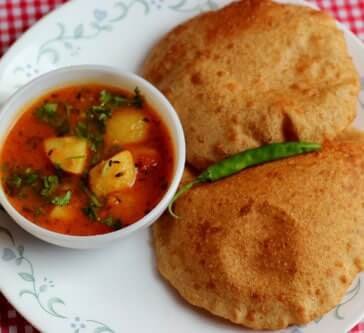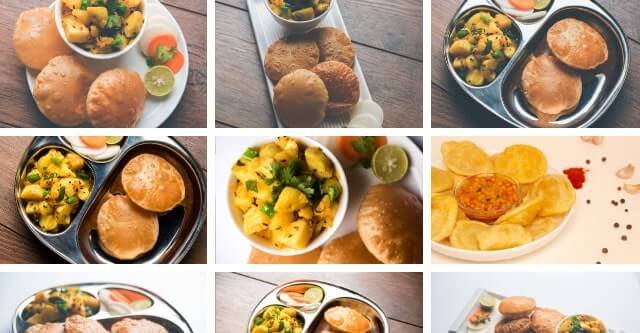Last Updated on January 31, 2021 by Dr Sharon Baisil MD
Our daily food habits dictate our health and its consequences. Thus, it becomes extremely necessary to make wise choices for this essential element of life.
Breakfast is often said to be the most important meal of the day. A good plate of breakfast will define how good your day will be. Among the endless breakfast options available, we often like to make it a healthy one.
A very common healthy meal option for Indians is the popular – Puri and Aloo ki Sabzi. It is a traditional Indian breakfast and is popular all around the country.
But now that you are here thinking about health, you might be wondering …
- Is Puri and Aloo ki Sabzi healthy?
- Is it safe for diabetics?
- What is the calorie content of it?
- What is its nutritional Composition?
- What are the benefits of eating Puri and Aloo ki Sabzi?
Well, we will answer and clear these doubts that you have correctly thought about. So let us get started.
What is Puri and Aloo ki Sabzi?

Puri or Poori is commonly known to be an Indian bread option is a very famous and rather beloved food option. It is best when combined with the simple but flavorful Aloo ki Sabzi or a spiced Potato preparation, or simply – potato curry.
This is a very common breakfast at festivals, during celebrations, on holidays, or anytime. It is tasty and very nutritious too.
The Puri is a type of bread made from white refined flour or even from regular whole wheat flour called Atta. It is made and enjoyed all over the Indian continent.
Puri is a very common bread item for breakfasts. It is always accompanied by a side dish, curry, chutney, or gravy. Puri paired with anything and everything is a treat.
It is most commonly paired with the easy to make and healthy Aloo ki Sabzi. This simple combination is heavenly for the mouth’s flavors and is undoubtedly a very popular choice.
But is the Puri and Aloo ki Sabzi the right combo to be called a healthy meal?
Well, let us find out.
Is Puri and Aloo ki Sabzi healthy?

Well, this might not be the most favorable combination if you are looking for a healthy option. Puri and Aloo ki Sabzi is more of a tasty meal than a healthy one.
It is not healthy as every day or even for frequent breakfast options. It is rather a fat and carbohydrate filled dish that can divert you from your weight loss or health-specific goals.
Although it can be made from healthy whole wheat flour, Puri is still unfit for the body as it is deep-fried in oil. Excess carbohydrates from flour and this paired with oil are a very unhealthy combination.
The side dish that the Puri is paired with, that is, Aloo ki Sabzi is another dish filled with carbohydrates. Potatoes are rich sources of starch that contribute to excess direct sugar and glucose in the body.
Thus, this is a fat, carbohydrate, and oil-rich fish. It is high in calories too and can lead to other health complications in the body such as – Weight gain, Diabetes, cholesterol, etc.
Too many calories are unhealthy for the body and need a lot of activity to burn completely.
This popular Indian combination cuisine should be had in fewer amounts and very rarely. This will keep the body healthy and out of risk of disease development.
Puri is a type of bread that should be had in moderation. Nutritionists and dieticians advise against the consumption of Puri daily.
Let us move on to knowing what the other effects of Puri and Aloo ki Sabzi are.
Can Diabetics Eat Puri and Aloo ki Sabzi?

As we already learned, the carbohydrate content of the Puri and Aloo ki Sabzi is a lot. This is unfavorable for someone who is suffering from blood sugar disorders.
Therefore, Puri and Aloo ki deemed as unsafe and harmful for anyone who is diagnosed with diabetes. They must avoid it or have it very seldom and in moderated quantities.
Puri is also a big no for diabetics as it is a deep-fried item. This can lead to blood sugar imbalance, increased fat in the body, and increased severity of heart diseases or cholesterol issues.
Potatoes are among the very first items in the list of unhealthy foods for diabetes. It is a starchy tuber, which adds to the body’s glucose directly. It is thus not recommended for anyone who wants to manage their body’s blood sugar levels.
Diabetics must always take care of the calories and the number of carbohydrates that they consume. This is a good way to keep safe and maintain a controlled diabetic condition.
What are the Glycemic Index and Glycemic Load of this dish?
The Glycemic ranges are very accurate measurements to ensure the safety and healthiness of food.
The categorization of food into safe or unsafe ranges based on a scale from 0 to 100 helps us determine food safety and its consequences on health.
The Glycemic values show the number of carbohydrates and assist in determining the effects on sugar levels.
| Sl. No. | Glycemic Index categories | Glycemic Index ranges |
| 1. | Low Glycemic Index (safe for diabetics) | 0 to 55 |
| 2. | Medium Glycemic Index (safe if taken in controlled quantities) | 55 to 69 |
| 3. | High Glycemic Index (unsafe for diabetics) | From 70 and above |
The Glycemic Index of a Whole-wheat flour Puri is 57. This means that the Carbohydrate content of it is higher than the recommended amount for diabetics.
It falls under the medium Glycemic Index range and must be had in low and moderated amounts.
On the other hand, the Glycemic Index of boiled and cooked Potatoes is – over 78. This is a very high Glycemic value. This makes it an unfit food item for many health types, especially for diabetics.
| Sl. No. | Glycemic Load categories | Glycemic Load ranges |
| 1. | Low Glycemic Load (safe for diabetics) | 0 to 10 |
| 2. | Medium Glycemic Load (safe if taken in controlled quantities) | 11 to 19 |
| 3. | High Glycemic Load (unsafe for diabetics) | Above 19 |
As per this table, let us look at the Glycemic Load of Puri and Aloo ki Sabzi.
The Glycemic Load of deep-fried whole wheat Puri is measured to be 28. This is a number way past the high Glycemic Load value. Therefore, it is proven that more quantities of the Puri can hamper with health and thus needs to be had in controlled amount sonly.
Similarly, the glycemic load of potatoes is also high. Thus, when cooked and combined with the high GL Puri, the Aloo ki Sabzi only adds to the dish’s calories and carbs.
Thus to conclude, this combination Indian dish is unsuitable if you are looking for a healthy food option.
Calories in Puri and Aloo ki Sabzi

All this while, we talked about how the Puri and Aloo ki Sabzi dish is not a healthy choice because of its high-calorie value. Now, let us have a look at the actual calorie content of this popular dish is.
- One Puri has around 141 calories. It has 88 calories from fat alone. More servings of Puri will add to the calories accordingly.
- When it comes to homemade Aloo ki Sabzi, a regular serving size has almost 45 calories.
When combined, this dish’s calorie count falls on a higher side and is said to be harmful to the body.
What are the key Nutrients in Puri and Aloo ki Sabzi?

Let us look at the various nutrients found in this particular popular Indian breakfast dish. This will help us to determine its safety or harm depending on our health better.
Nutritional Composition of one Puri:
| Sl. No. | Nutrients available | Amount available |
| 1. | Calories | 141 |
| 2. | Total fats – Saturated fats – Trans fat – Polyunsaturated fats – Monounsaturated fats | 9.8 g – 0.8 g – 0.2 g – 6.3 g – 2.2 g |
| 3. | Total carbohydrates – Dietary fiber – Sugars | 12 g – 1.8 g – 0.1 g |
| 4. | Protein | 2.3 g |
| 5. | Cholesterol | 0 mg |
| 6. | Sodium | 85 mg |
| 7. | Potassium | 62 mg |
| 8. | Calcium | 0.5% |
| 9. | Iron | 3.5% |
Nutritional Composition of Aloo ki Sabzi:
| Sl. No. | Nutrients available | Amount available |
| 1. | Calories | 45 |
| 2. | Total fat | 4 g |
| 3. | Total carbohydrates – Dietary fiber | 3 g – 1 g |
| 4. | Cholesterol | 5 mg |
| 5. | Sodium | 220 mg |
| 6. | Calcium | 2% |
| 7. | Iron | 2% |
| 8. | Vitamin A | 2% |
7 Health Benefits of Puri and Aloo ki Sabzi
After knowing the nutritional value of this combination of food, let us look at the benefits.
- This carb-rich dish is good for providing instant energy to the body.
- It is filling and keeps you active all day. Hence, a great choice for breakfast.
- You can also attain fiber from this food combo, which is good for the whole digestive system.
- This dish also adds various vitamins and minerals to the body, such as zinc, vitamin B3, Folic acid, etc.
- Potatoes are loaded with several helpful antioxidants that keep the body safe and protected from diseases.
- Potatoes being rich in Vitamin B6, assist in continuously building new cells in the body.
- It is easy to make and tasty dish that is enjoyed by all.
References
- https://pubmed.ncbi.nlm.nih.gov/10953672/
- https://pubmed.ncbi.nlm.nih.gov/30441846/
- https://pubmed.ncbi.nlm.nih.gov/27240356/
- https://pubmed.ncbi.nlm.nih.gov/26920281/
- https://pubmed.ncbi.nlm.nih.gov/30441982/
- https://pubmed.ncbi.nlm.nih.gov/28442643/
- https://pubmed.ncbi.nlm.nih.gov/29063379/
- https://pubmed.ncbi.nlm.nih.gov/30104491/
- https://pubmed.ncbi.nlm.nih.gov/31514301/
- https://pubmed.ncbi.nlm.nih.gov/31728494/





